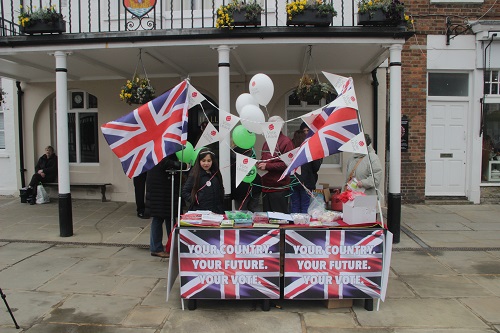This remote class is on the actual construction of a basic stall. The other two parts are on the strategic place of the Street Stall in your broader campaign strategy, and, the operation of the Street Stall including the deployment and disposition of your activists.
We have chosen Eddy Burrows of Ashford Out as he has developed a good little stall over the years campaigning for the Conservative Party and, lately, UKIP before taking a leading role in Ashford's autonomous and united Asford Out.
The presenter is Andy Wall, coordinator of VoteLeave, Folkestone and Hythe constituency.
- Considerations
- Effectiveness
- Ease of Construction and Assembly
- Cheapness of Construction
- Sturdiness
- Lightness carry and fit-into-a-car-boot-ability-ness.
Of course, you make a better stall by welding up a load of box-section but, as the soldier said, I am not a real welder.
This stall is designed to get you on the street for just a few quid but with a stall that will be effective, professional but still have that important, authentic, home-made look.
First of all, sit back and watch Andy and Eddy show you the stall. Please see the video above.
We have sourced the particular table used. It is a walllpaper pasting table but is far superior to the ordinary pasting table in that it can carry far more weight of leaflets and is useful as a picnic table in other campaign situations. It is also more robust and able to support the uprights demostrated here. The uprights are, ofcourse, critical to the effectiveness of your stall.
You will see that, at £30, it is more expensive than the basic hardboard table but is far superior. And you should be able to get away without much more expense.
Other materials you will need will be:
Uprights: these might be anything from old tent poles to bits of old copper piping that are left around. Eddy uses ordinary plastic garden poles stuck into the pipe in order to make them two piece and easy to carry. He also goes for flexible plastic pipe so that his flags move a little, which is visually attractive.
The hook system on the lowere legs can be made from heavy fuse wire, a coat hanger or some of that aluminium electrical wire they used in Soviet times.
If you chose to suspend a banner between the uprights, you will almost certainly need to use a solid, stiff upright. This stall should be strong enough to support a lightweight banner (such as made from and old bedsheet, but maybe not a heavy, tarp or vinyl banner if it is very deep. In this case you will have to reinforce the legs with wood or some other horizontal using the same wing-nut sytem demonstrated by Eddy.
Some people do dispense with uprights because they have a pitch in front of something like an empty shop, or between some posts, where a banner can be suspended. These tricks will be considered in the tutorial on the operation of the stall.
Windiness may discourage you from use of eye-level displays but in bad weather consider water barrels and sand bagsto stabilise your stall. And consider something like Eddy's bagged stones to keep your leaflets in order.
You may well want to go further or already have such enhancements as a gazebo. A decorated gazebo canbe great and many campaigners swear by them, especially when it is too sunny or rainy. Again, you can often get cheap and nasty gazebos for £20 or less. They last just once or twice but decent ones can cost a bit. Of course, a decent one can be used all summer in the garden.
Most importantly feel free to innovate: use this advice to save time and get out there and enjoy your part in our victory in June.
Come back soon for the next tutorials on technics and the arguments
If you have found this useful, please consider making a small (or enormous) donation to Bruges Group or Join.





